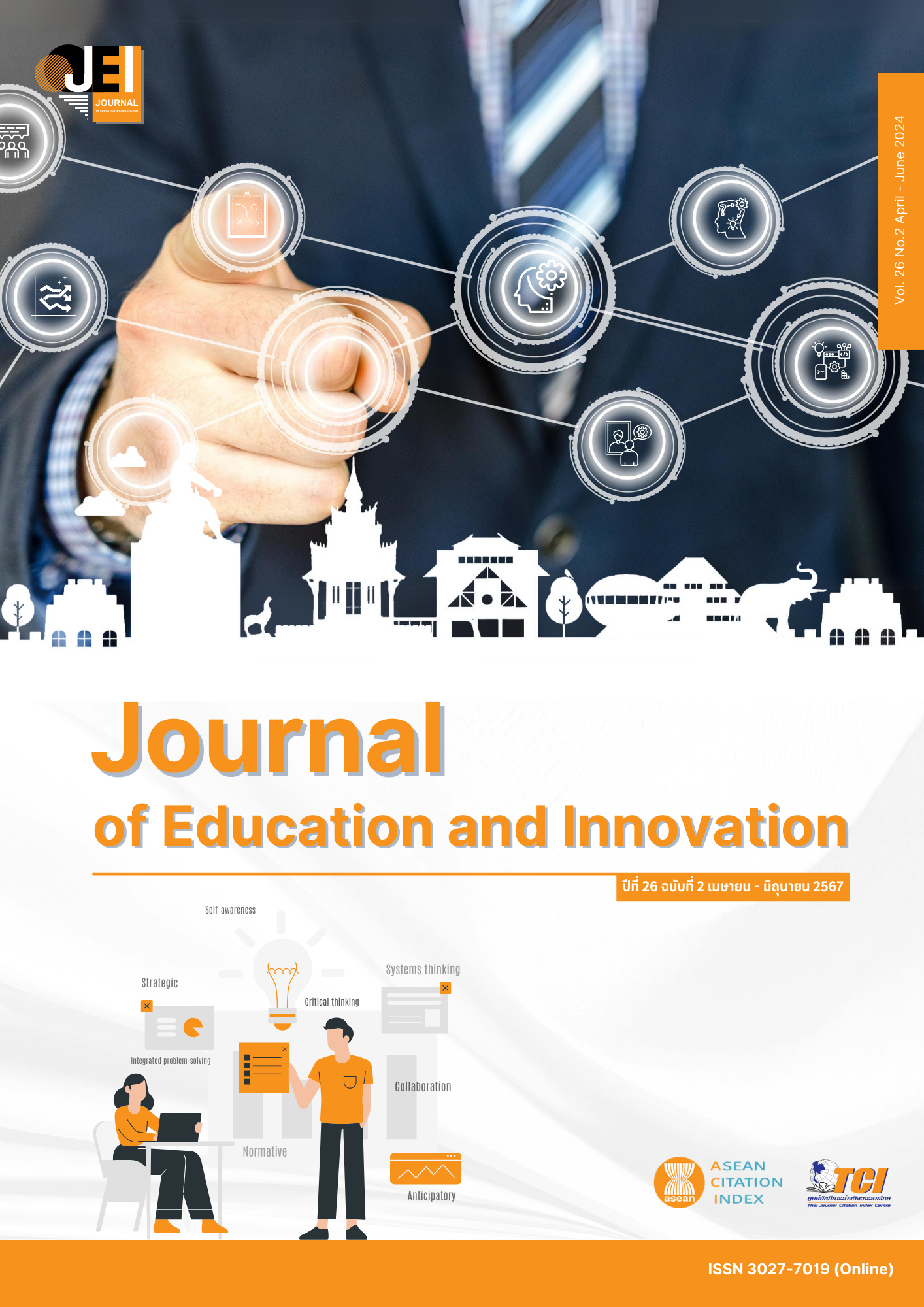การพัฒนาบอร์ดเกมเพื่อพัฒนาทักษะปัญญาประดิษฐ์และการเขียนโปรแกรม สำหรับนักศึกษาช่างอุตสาหกรรม
Main Article Content
บทคัดย่อ
การเขียนโปรแกรมเป็นทักษะหนึ่งที่มีความสำคัญในยุคที่เทคโนโลยีปัญญาประดิษฐ์กำลังเป็นที่แพร่หลาย ดังนั้นในงานวิจัยนี้มีวัตถุประสงค์เพื่อออกแบบและพัฒนาบอร์ดเกมที่พัฒนาทักษะปัญญาประดิษฐ์และการเขียนโปรแกรมสำหรับนักศึกษาช่างอุตสาหกรรม ศึกษาผลสัมฤทธิ์ทางการเรียน ศึกษาทักษะปัญญาประดิษฐ์และการเขียนโปรแกรม และ ศึกษาความคิดเห็นและความพึงพอใจของผู้เรียน ประชากร ได้แก่ นักศึกษาระดับชั้น ปวส. ปีที่ 1 และ 2 สาขาวิชาอิเล็กทรอนิกส์ มหาวิทยาลัยเทคโนโลยีราชมงคลอีสาน วิทยาเขตขอนแก่น จำนวน 4 ห้อง รวม 98 คน และกลุ่มตัวอย่าง ได้แก่ นักศึกษาระดับชั้น ปวส. ปีที่ 1 สาขาวิชาอิเล็กทรอนิกส์ มหาวิทยาลัยเทคโนโลยีราชมงคลอีสาน วิทยาเขตขอนแก่น จำนวน 31 คน ที่ได้จากการสุ่มตัวอย่างแบบกลุ่ม รูปแบบที่ใช้ในการทดลองคือ การวิจัยเชิงทดลองเบื้องต้น ที่มีกลุ่มเดียวและมีการทดสอบก่อนและหลังเรียน เครื่องมือที่ใช้ในการวิจัยได้แก่ บอร์ดเกมฯ แบบประเมินคุณภาพบอร์ดเกมฯ แบบวัดทักษะปัญญาประดิษฐ์และการเขียน แบบวัดผลสัมฤทธิ์ทางการเรียน และแบบสำรวจความคิดเห็นและความพึงพอใจของผู้เรียนที่มีต่อบอร์ดเกมฯ ผลการวิจัย พบว่า คุณภาพของบอร์ดเกม อยู่ที่ระดับดี ( = 4.20, S.D. = 0.42) ในด้านเนื้อหา อยู่ที่ระดับดี (
= 4.33, S.D. = 0.51) ด้านสื่อ อยู่ที่ ระดับดี (
= 4.25, S.D. = 0.34) และด้านการออกแบบ อยู่ที่ ระดับดี (
= 4.20, S.D. = 0.42) ผลการศึกษาทักษะปัญญาประดิษฐ์และการเขียนโปรแกรมพบว่าผู้เรียนสามารถแก้ปัญหาภารกิจได้คือ สามารถแยกปัญหาเป็นส่วนย่อยได้ ค้นหารูปแบบที่ซ้ำกัน และสามารถสร้างเส้นทางเดินที่สั้นที่สุดหรือใช้ระยะเวลาน้อยที่สุดได้ ผลสัมฤทธิ์ทางการเรียนของผู้เรียนหลังเรียนด้วยบอร์ดเกมพบว่ามีคะแนนเฉลี่ยหลังเรียน 19.52 คะแนน (S.D. = 3.69) สูงกว่าก่อนเรียนอย่างมีนัยยะสำคัญที่ 0.05 ความคิดเห็นและความพึงพอใจของผู้เรียนที่มีต่อบอร์ดเกมพบว่า อยู่ในระดับพึงพอใจมาก (
= 4.17, S.D. = 0.72) ในด้านเนื้อหา ระดับพึงพอใจมาก (
= 4.12, S.D. = 0.71) ด้านสื่อ มีค่าเฉลี่ยรวมอยู่ที่ระดับพึงพอใจมาก (
= 4.19, S.D. = 0.72) และด้านการออกแบบ ระดับพึงพอใจมาก (
= 4.19, S.D. = 0.71)
Article Details

This work is licensed under a Creative Commons Attribution-NonCommercial-NoDerivatives 4.0 International License.
เจ้าของบทความมิได้คัดลอก หรือละเมิดลิขสิทธิ์ของผู้ใด หากเกิดการละเมิดลิขสิทธิ์ ไม่ว่าวิธีใด หรือการฟ้องร้องไม่ว่ากรณีใด ๆ ที่อาจเกิดขึ้นได้ กองบรรณาธิการวารสารศึกษาศาสตร์ ไม่มีส่วนเกี่ยวข้องทั้งสิ้น ให้เป็นสิทธิ์ของเจ้าของบทความที่จะดำเนินการ
References
Bennedsen, J. (2008). Teaching and learning introductory programming: A model-based approach (Doctoral dissertation). Norway: University of Oslo.
Figueiredo, J., & García-Peñalvo, F. J. (2020). Increasing student motivation in computer programming with gamification. 2020 IEEE Global Engineering Education Conference (EDUCON). USA: IEEE.
Hunsaker, E. (2020). Computational thinking. In A. Ottenbreit-Leftwich, & R. Kimmons (Ed.), The K-12 educational technology handbook. Retrieved from https://edtechbooks.org/k12handbook
Iamjitkuson, P. (2021). Does AI technology affect employment, and how does employee adaptation? Retrieved from https://www.depa.or.th/th/article-view/ai-employment [in Thai]
Khongtanakunbawon, P., Jeekartok, K., Khongtanakunbawon, W., Phukongchana, P., & Sangsawang, N. (2023). The development of board game learning computing science in using technology safely for matthomyomsuksa 1. Journal of Humanities, Social Sciences, and Arts, 4(2), 1–9.
Keawmorakote, U., Noiying, P., & Koseeyaporn, P. (2020). Organizing blended learning for learning center subject: application of artificial intelligence in the industrial sector. Journal of Education and Innovation, 24(3), 326–337.
Maneehaet, S., & Wannapiroon, P. (2019). A digital learning ecosystem with artificial intelligence for smart learning. Journal of Education and Innovation, 21(2), 359–373.
Pandam, S. (2022). Upskilling and reskilling strategies to enhance vocational workforce in the era of disruptive technologies. The National Defense College of Thailand Journal, 63(1), 124-133. [in Thai]
Prainetr, S. (2023). Development of innovation instructional artificial intelligence for youth in provinces in special economic development zones Nakhon Phanom and Mukdahan. T-VET Journal, 7(13), 126–136.
Richey, R. C., & Klein, J. D. (2007). Design and Development Research: Methods, Strategies, and Issues. Routledge. https://doi.org/10.4324/9780203826034
Rowe, E., Asbell-Clarke, J., Gasca, S., & Cunningham, K. (2017). Assessing implicit computational thinking in zoombinis gameplay. The International Conference on the Foundations of Digital Games - FDG ’17. USA: Association for Computing Machinery.
Sittiwong, T. (2021). The effects of using board game to promote learning for undergraduate students Faculty of Education Naresuan University. Journal of Education and Innovation, 23(4), 187–200.
Srisa–Ard, B., (2002). Basic research (7th ed). Bangkok. Suweerivasarn.
Sudjitjoon, W., khodchapong, N., Treephongphan, U., Khongtan, K., & Hengpraprohm, S. (2022). The effectiveness of ai learning innovation for elementary school children. Journal of Buddhist Anthropology, 7(10), 327–338.
Tangpakdee, R. (2022). The The development of board games production model for education in Thailand. STOU Educational Journal, 15(2), 117-132.
Thammabut, T., Chueakun, P., Kaewthon, R., & Wonganu, P. (2022). The development of a board game to enhance computational thinking skill and motivation in computer programming course for undergraduate students. Journal of Information and Learning, 33(3), 34–45.
Waiyanet, W. (2022). Achievement with MIAP teaching method via board game on stack for diploma level. Journal of Industrial Education, 21(3), 24–33.
Wing, J. M. (2006). Computational thinking. Communications of the ACM, 49(3), 33-35.

